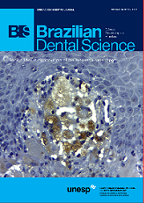Patient satisfaction after orthodontic treatment: a systematic review
DOI:
https://doi.org/10.14295/bds.2017.v20i2.1403Abstract
Objective: To conduct a systematic review of the literature about the factors that drive patients toward satisfaction after orthodontic treatment. Material and Methods: The review was registered in PROSPERO (CRD42013004528). Four databases as well as the reference lists and citations of the included publications were searched according to PRISMA guidelines, yielding 6.387 titles and abstracts. Two reviewers performed data collection independently and a third reviewer was included, if there was no consensus. Results: Nine surveys (2.742 participants) remained after data extraction and interpretation. A total of 14 findings were abstracted from the reports and were grouped together into 4 topics that were judged to be similar: treatment, aesthetics, function and social well-being. The main findings for adherence based on their calculated frequency effect sizes were: self-perception of esthetics of teeth (44%); harmony of the teeth with other structures of the face (44%); alignment of anterior teeth (33%); greater comfort, absence of pain and improved chewing/ eating (33%); social well-being (33%); treatment was worth it (33%). Conclusion: Despite the few studies and limitations related to the report and data quality, the evidence showed the main factor leading to patient satisfaction was improved aesthetics. Chewing, absence of pain, social wellbeing and the way treatment was conducted were highlighted as reasons for patient satisfaction after orthodontic treatment. KEYWORDS Corrective orthodontics; Patient satisfaction; Systematic review.
Keywords
Corrective orthodontics; Patient satisfaction; Systematic review.
Downloads
Downloads
Additional Files
Published
How to Cite
Issue
Section
License
Brazilian Dental Science uses the Creative Commons (CC-BY 4.0) license, thus preserving the integrity of articles in an open access environment. The journal allows the author to retain publishing rights without restrictions.
=================




























